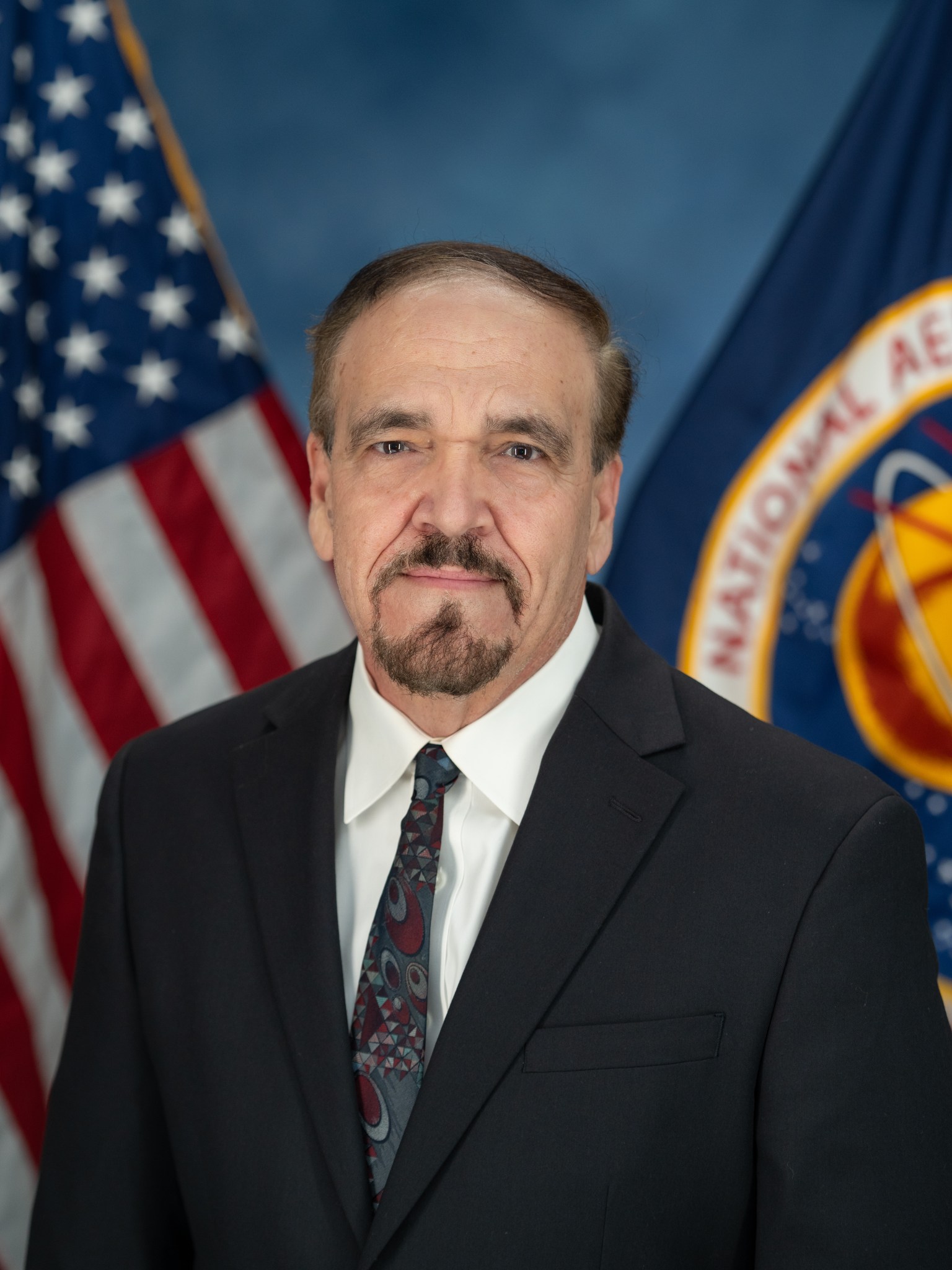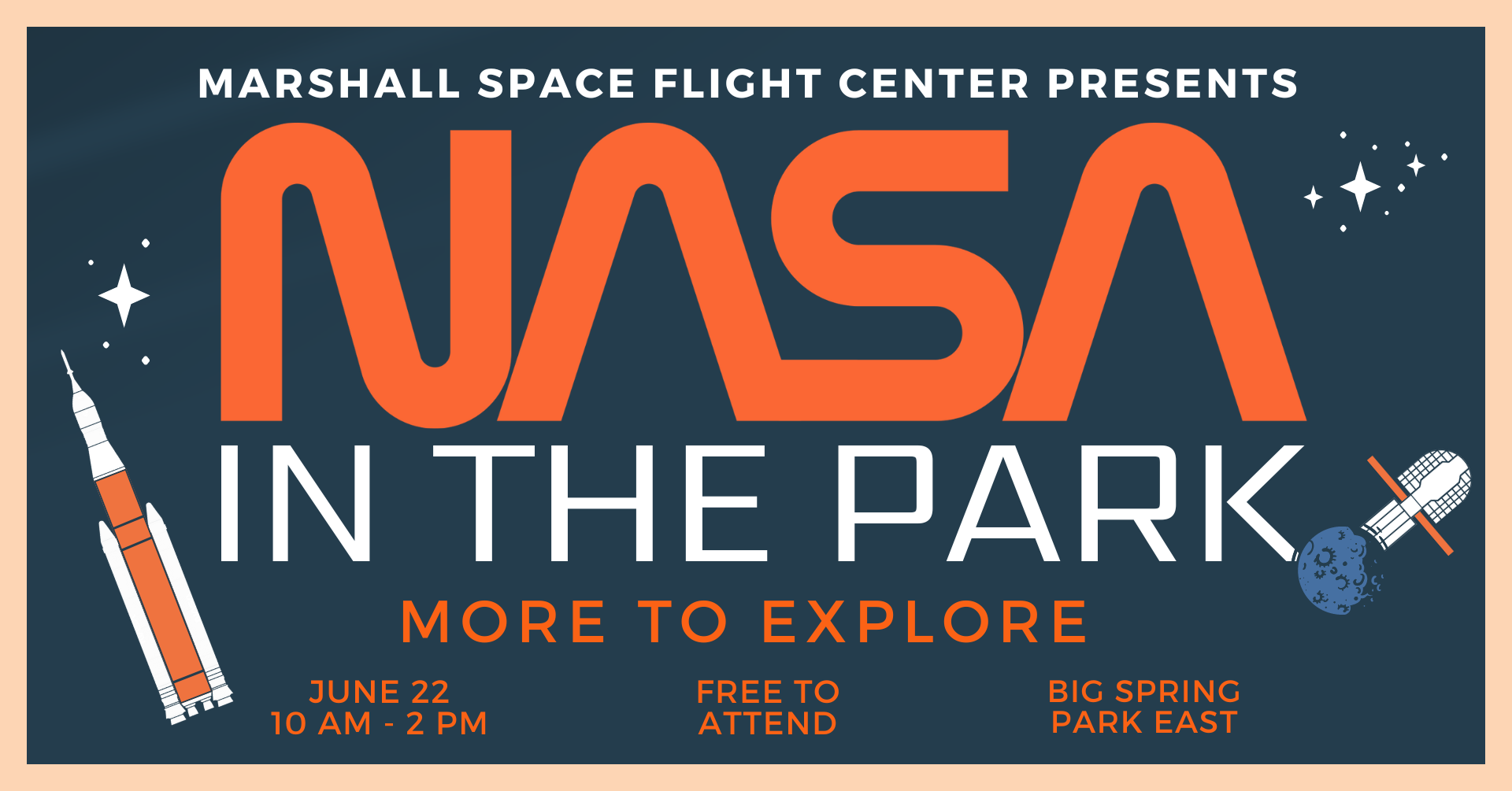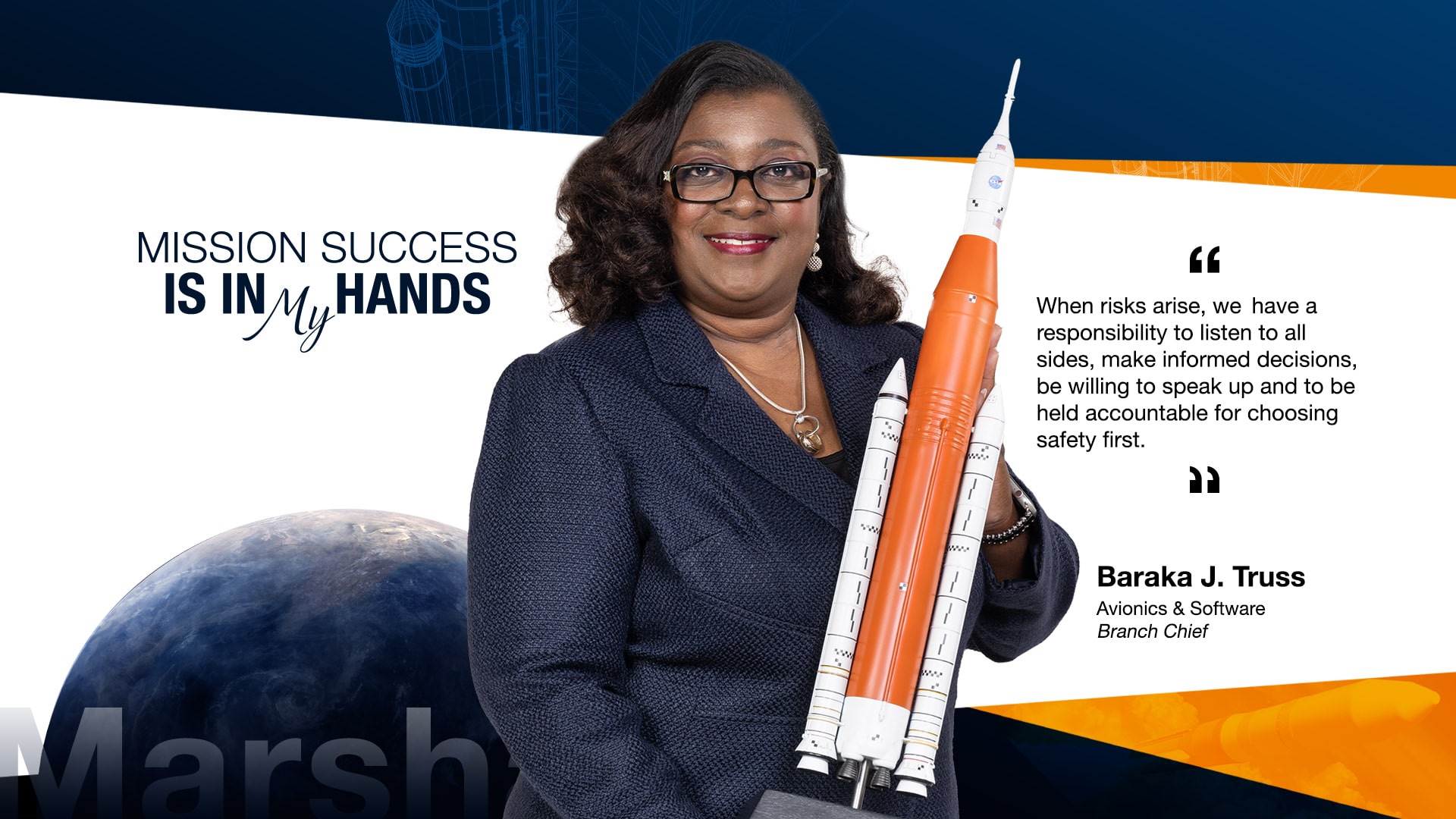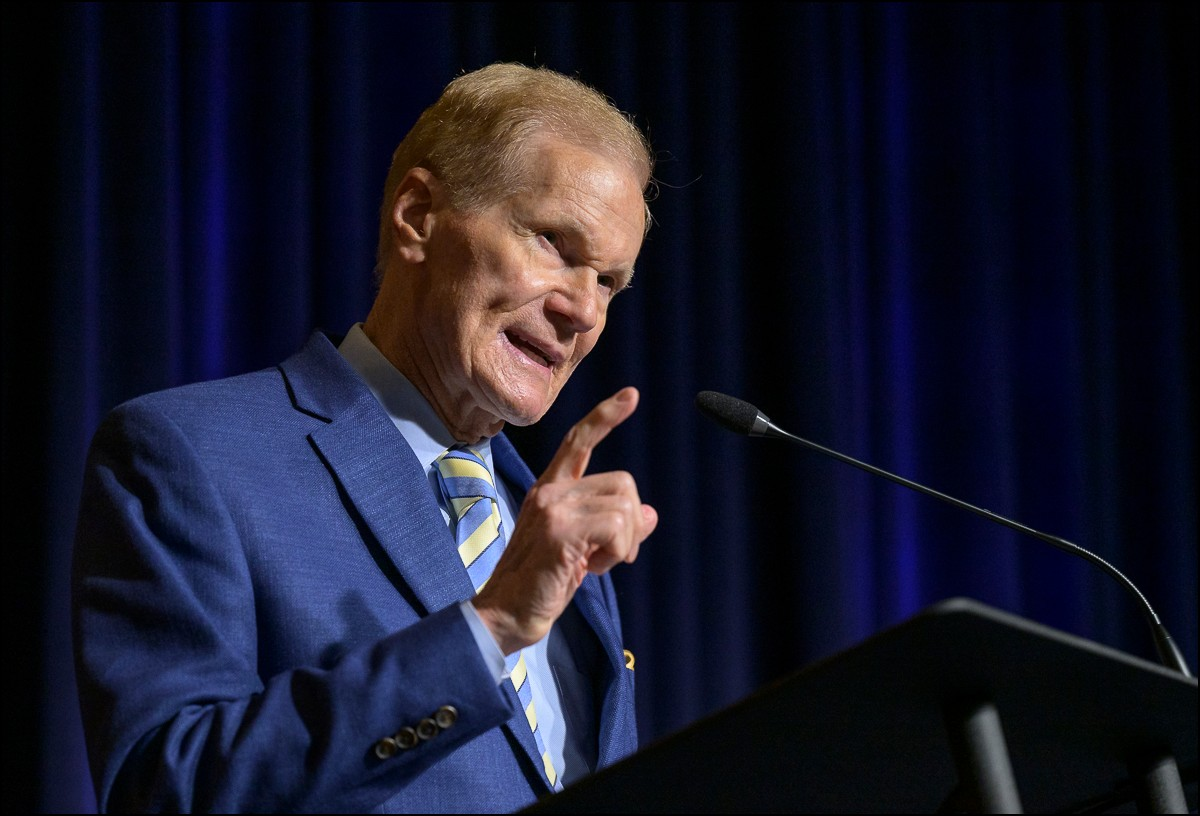The Marshall Star for June 18, 2024
California Teams Win $1.5 Million in NASA’s Break the Ice Lunar Challenge By Savannah Bullard After two days of live competitions, two teams from southern California are heading home with a combined $1.5 million from NASA’s Break the Ice Lunar Challenge. Since 2020, competitors from around the world have competed in this challenge with the […]
The Marshall Star for June 18, 2024
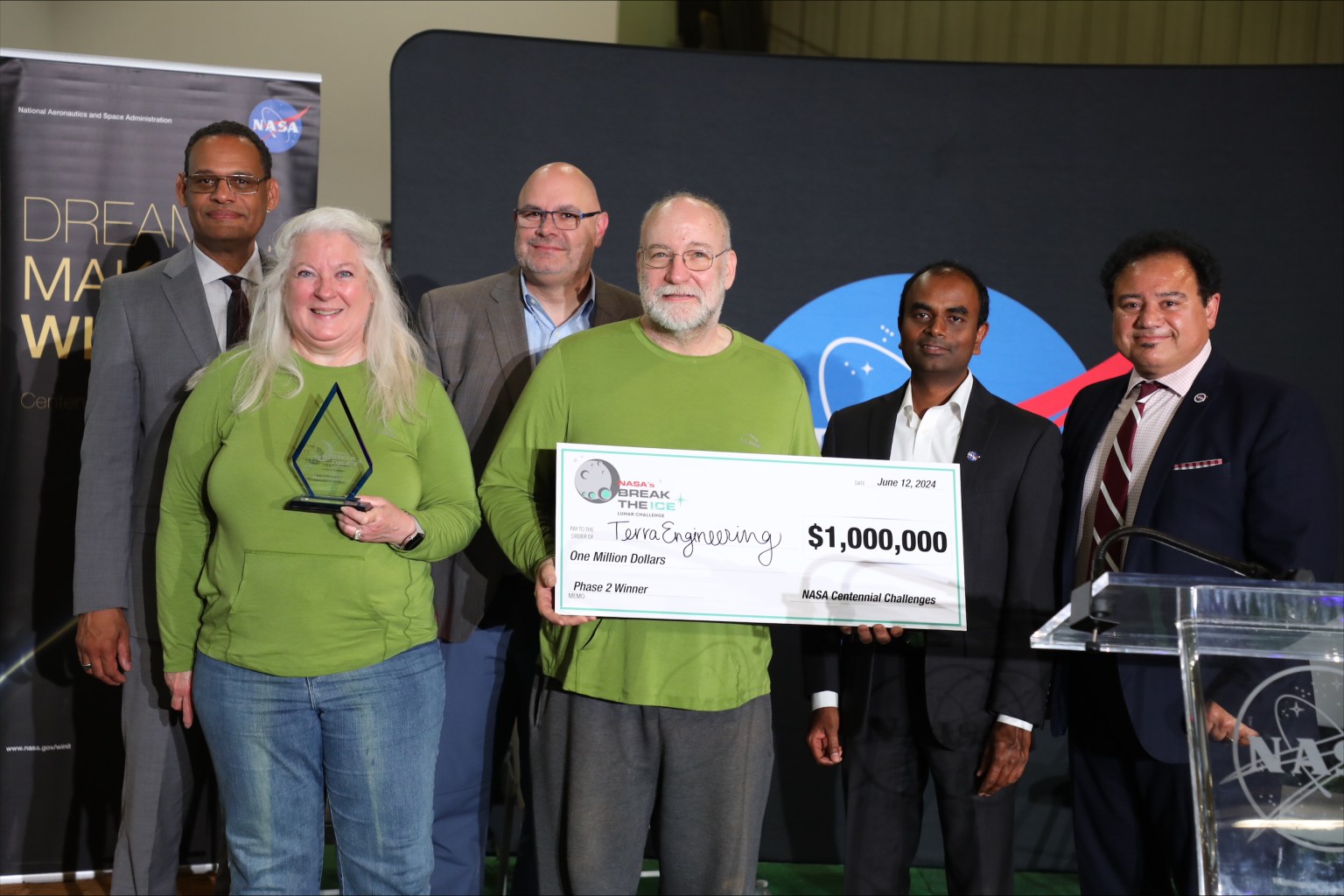
California Teams Win $1.5 Million in NASA’s Break the Ice Lunar Challenge
By Savannah Bullard
After two days of live competitions, two teams from southern California are heading home with a combined $1.5 million from NASA’s Break the Ice Lunar Challenge.
Since 2020, competitors from around the world have competed in this challenge with the common goal of inventing robots that can excavate and transport the icy regolith on the Moon. The lunar South Pole is the targeted landing site for crewed Artemis missions, so utilizing all resources in that area, including the ice within the dusty regolith inside the permanently shadowed regions, is vital for the success of a sustained human lunar presence.
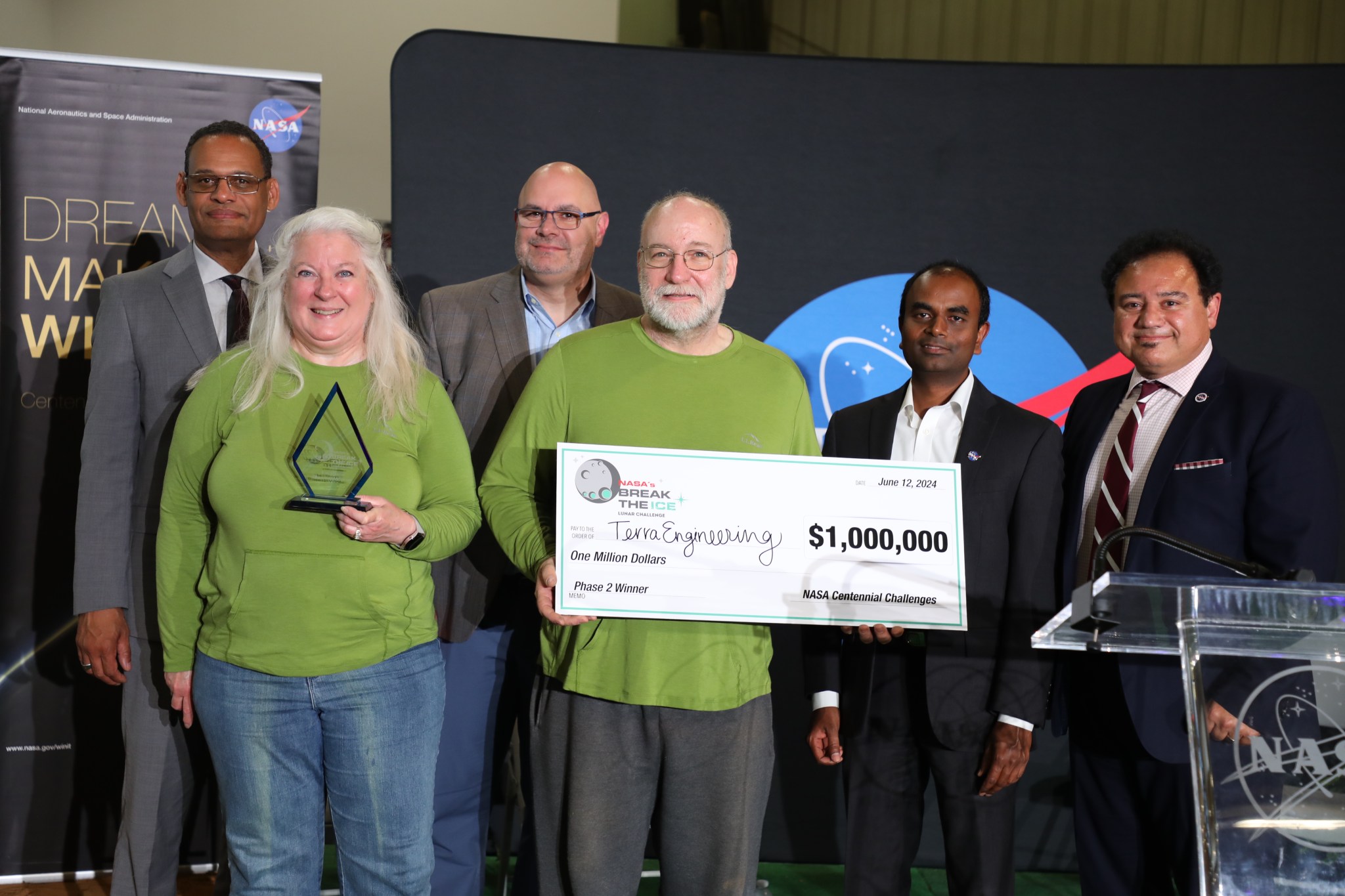
On Earth, the mission architectures developed in this challenge aim to help guide machine design and operation concepts for future mining and excavation operations and equipment for decades.
“Break the Ice represents a significant milestone in our journey toward sustainable lunar exploration and a future human presence on the Moon,” said Joseph Pelfrey, center director of NASA’s Marshall Space Flight Center. “This competition has pushed the boundaries of what is possible by challenging the brightest minds to devise groundbreaking solutions for excavating lunar ice, a crucial resource for future missions. Together, we are forging a future where humanity ventures further into the cosmos than ever before.”
The final round of the Break the Ice competition featured six finalist teams who succeeded in an earlier phase of the challenge. The competition took place at the Alabama A&M Agribition Center in Huntsville on June 11 and 12, where each team put their diverse solutions to the test in a series of trials, using terrestrial resources like gravity-offloading cranes, concrete slabs, and a rocky track with tricky obstacles to mimic the environment on the Moon.
The husband-and-wife duo of Terra Engineering took home the top prize for their “Fracture” rover. Team lead Todd Mendenhall competed in NASA’s 2007 Regolith Excavation Challenge, facilitated through NASA’s Centennial Challenges, which led him and Valerie Mendenhall to continue the pursuit of solutions for autonomous lunar excavation.
A small space hardware business, Starpath Robotics, earned the second-place prize for its four-wheeled rover that can mine, collect, and haul material. The team, led by Saurav Shroff and lead engineer Mihir Gondhalekar, developed a robotic mining tool that features a drum barrel scraping mechanism for breaking into the tough lunar surface. This allows the robot to mine material quickly and robustly without sacrificing energy.
“This challenge has been pivotal in advancing the technologies we need to achieve a sustained human presence on the Moon,” said Kim Krome, the Acting Program Manager for NASA’s Centennial Challenges. “Terra Engineering’s rover, especially, bridged several of the technology gaps that we identified – for instance, being robust and resilient enough to traverse rocky landscapes and survive the harsh conditions of the lunar South Pole.”
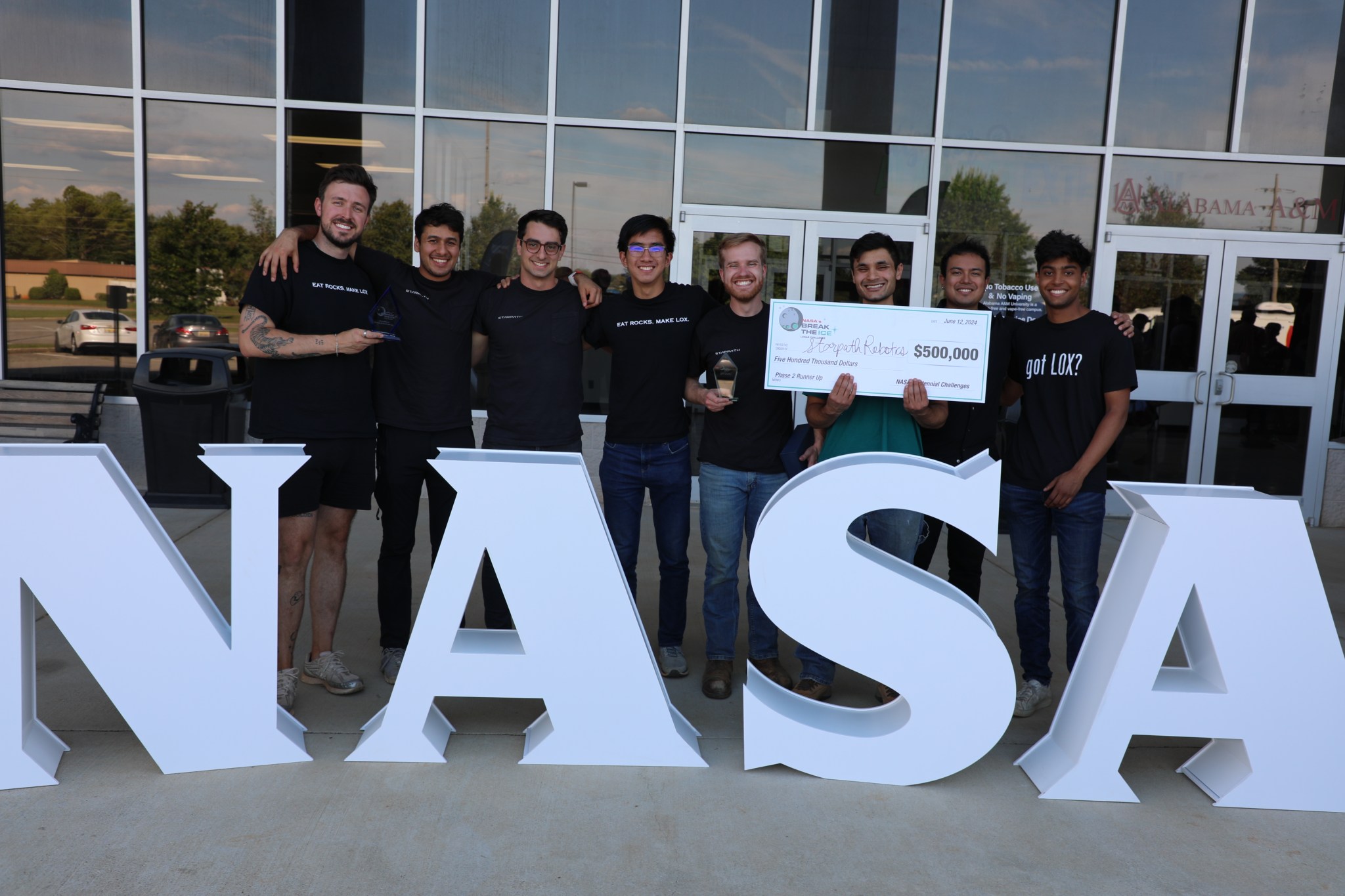
Beyond the $1.5 million in prize funds, three teams will be given the chance to use Marshall Space Flight Center’s thermal vacuum (TVAC) chambers to continue testing and developing their robots. These chambers use thermal vacuum technologies to create a simulated lunar environment, allowing scientists and researchers to build, test, and approve hardware for flight-ready use.
The following teams performed exceptionally well in the excavation portion of the final competition, earning these invitations to the TVAC facilities:
- Terra Engineering (Gardena, California)
- Starpath Robotics (Hawthorne, California)
- Michigan Technological University – Planetary Surface Technology Development Lab (Houghton, Michigan)
“We’re looking forward to hosting three of our finalists at our thermal vacuum chamber, where they will get full access to continue testing and developing their technologies in our state-of-the-art facilities,” said Break the Ice Challenge Manager Naveen Vetcha, who supports NASA’s Centennial Challenges through Jacobs Space Exploration Group. “Hopefully, these tests will allow the teams to take their solutions to the next level and open the door for opportunities for years to come.”
NASA’s Break the Ice Lunar Challenge is a NASA Centennial Challenge led by the agency’s Marshall Space Flight Center, with support from NASA’s Kennedy Space Center. Centennial Challenges are part of the Prizes, Challenges, and Crowdsourcing program under NASA’s Space Technology Mission Directorate. Ensemble Consultancy supports challenge competitors. Alabama A&M University, in coordination with NASA, supports the final competitions and winner event for the challenge.
Bullard, a Manufacturing Technical Solutions Inc. employee, supports the Marshall Office of Communications.
NASA Announces Winners of 2024 Student Launch Competition
Over 1,000 students from across the U.S. and Puerto Rico launched high-powered, amateur rockets on April 13, just north of NASA’s Marshall Space Flight Center, as part of the agency’s annual Student Launch competition.
Teams of middle school, high school, college, and university students were tasked to design, build, and launch a rocket and scientific payload to an altitude between 4,000 and 6,000 feet, while making a successful landing and executing a scientific or engineering payload mission.
“These bright students rise to a nine-month challenge that tests their skills in engineering, design, and teamwork,” said Kevin McGhaw, director of NASA’s Office of STEM Engagement Southeast Region. “They are the Artemis Generation, the future scientists, engineers, and innovators who will lead us into the future of space exploration.”
NASA announced the University of Notre Dame is the overall winner of the agency’s 2024 Student Launch challenge, followed by Iowa State University, and the University of North Carolina at Charlotte. A complete list challenge winners can be found on the agency’s student launch web page. NASA presented the 2024 Student Launch challenge award winners in a virtual award ceremony June 7.
Each year NASA implements a new payload challenge to reflect relevant missions. This year’s payload challenge is inspired by the Artemis missions, which seek to land the first woman and first person of color on the Moon.
The complete list of award winners are as follows:
2024 Overall Winners
- First place: University of Notre Dame, Indiana
- Second place: Iowa State University, Ames
- Third place: University of North Carolina at Charlotte
3D Printing Award:
College Level:
- First place: University of Tennessee Chattanooga
Middle/High School Level:
- First place: First Baptist Church of Manchester, Manchester, Connecticut
Altitude Award
College Level:
- First place: Iowa State University, Ames
Middle/High School Level:
- First place: Morris County 4-H, Califon, New Jersey
Best-Looking Rocket Award:
College Level:
- First place: New York University, Brooklyn, New York
Middle/High School Level:
- First place: Notre Dame Academy High School, Los Angeles
American Institute of Aeronautics and Astronautics Reusable Launch Vehicle Innovative Payload Award:
College Level:
- First place: University of Colorado Boulder
- Second place: Vanderbilt University, Nashville, Tennessee
- Third place: Carnegie Mellon, Pittsburgh, Pennsylvania
Judge’s Choice Award:
Middle/High School Level:
- First place: Cedar Falls High School, Cedar Falls, Iowa
- Second place: Young Engineers in Action, LaPalma, California
- Third place: First Baptist Church of Manchester, Manchester, Connecticut
Project Review Award:
College Level:
- First place: University of Florida, Gainesville
AIAA Reusable Launch Vehicle Award:
College Level:
- First place: University of Florida, Gainesville
- Second place: University of North Carolina at Charlotte
- Third place: University of Notre Dame, Indiana
AIAA Rookie Award:
College Level:
- First place: University of Colorado Boulder
Safety Award:
College Level:
- First place: University of Notre Dame, Indiana
- Second place: University of Florida, Gainesville
- Third place: University of North Carolina at Charlotte
Social Media Award:
College Level:
- First place: University of Colorado Boulder
Middle/High School Level:
- First place: Newark Memorial High School, Newark, California
STEM Engagement Award:
College Level:
- First place: University of Notre Dame, Indiana
- Second place: University of North Carolina at Charlotte
- Third place: New York University, Brooklyn, New York
Middle/High School Level:
- First place: Notre Dame Academy High School, Los Angeles, California
- Second place: Cedar Falls High School, Cedar Falls, Iowa
- Third place: Thomas Jefferson High School for Science and Technology, Alexandria, Virginia
Service Academy Award:
First place: United States Air Force Academy, USAF Academy, Colorado
Vehicle Design Award:
Middle/High School Level:
- First place: First Baptist Church of Manchester, Manchester, Connecticut
- Second place: Explorer Post 1010, Rockville, Maryland
- Third place: Plantation High School, Plantation, Florida
Payload Design Award:
Middle/High School Level:
- First place: Young Engineers in Action, LaPalma, California
- Second place: Cedar Falls High School, Cedar Falls, Iowa
- Third place: Spring Grove Area High School, Spring Grove, Pennsylvania
Student Launch is one of NASA’s nine Artemis Student Challenges, activities which connect student ingenuity with NASA’s work returning to the Moon under Artemis in preparation for human exploration of Mars.
The competition is managed by Marshall’s Office of STEM Engagement (OSTEM). Additional funding and support are provided by NASA’s OSTEM via the Next Gen STEM project, NASA’s Space Operations Mission Directorate, Northrup Grumman, National Space Club Huntsville, American Institute of Aeronautics and Astronautics, National Association of Rocketry, Relativity Space, and Bastion Technologies.
Keith Savoy Named Deputy Director at Michoud Assembly Facility
Keith Savoy has been named deputy director of NASA’s Michoud Assembly Facility, effective June 16.
Savoy will assist in managing the day-to-day operations of one of the world’s largest manufacturing facilities, where key elements of NASA’s Space Launch System (SLS), and Orion spacecraft are built. Michoud, a multi-tenant manufacturing site sitting on 829 acres with over 2 million square feet of manufacturing space, is managed by NASA’s Marshall Space Flight Center and provides facility infrastructure and capacity for federal, state, academic, and technology-based industry partners.
Savoy was the chief operating officer of Michoud Assembly Facility from 2022-2024, where he oversaw the day-to-day administrative and operational functions of the NASA-owned facility, helping sustain SLS and Orion production efforts and coordinating requirements and logistics with Michoud tenant leadership for approximately 3,500 Michoud employees.
He previously served as manager of the Office of Center Operations of Michoud from 2016-2022. His responsibilities included managing the facility’s planning, maintenance, design, construction, and engineering. Savoy also oversaw energy and water conservation, environmental permitting and compliance, industrial hygiene, and medical, security, and logistics services, where he was responsible for managing over $350 million of supplemental funding projects sitewide.
Savoy also held the position of lead engineer, Logistics and Operation Planning for NASA from 2007-2016 at Michoud as an expert consultant for all engineering aspects of the facility. He managed multi-phase projects and helped advance aerospace manufacturing at Michoud to meet the complex requirements of SLS and Orion multi-purpose crew vehicle programs, ensuring environmental compliance. Savoy worked closely with local, state, and federal environmental regulatory agencies to identify and resolve engineering and environmental issues. His expertise was a key contributor to ensuring NASA’s sustainable and environmental goals were achieved.
Prior to working for NASA, Savoy held several positions of increasing responsibility with Lockheed Martin from 1988-2007. As manager of Operational Planning and Layout, he was responsible for managing the Construction of Facilities. This required developing and implementing plans, outlining scope-of-work, overseeing large-scale project budgets, and Project Definition Rating assessment/score and 1509 development. Savoy implemented Six Sigma & Lean principles concepts to achieve many successes and identified innovative solutions and best practices to satisfy customer requirements. Savoy was also the manager of the Infrastructure Enhancement Team where he managed over 160 personnel and a $10 million budget.
Savoy has a Master of Science in environmental management from National Technological University in Fort Collins, Colorado, a bachelor of science in electrical engineering from the University of Louisiana-Lafayette, and a technical degree in industrial instrumentation from International Technical Institute in Baton Rouge, Louisiana.
Throughout his career, Savoy has received various awards including the NASA Honor Award Outstanding Leadership Medal, Director’s Commendation Honor Award, Safety Flight Awareness Awards, and several Silver Medal Group Achievement Awards.
‘NASA in the Park’ Returns to Rocket City June 22
NASA in the Park is coming back to Big Spring Park East in Huntsville, Alabama, on June 22, from 10 a.m. to 2 p.m. CDT. The event is free and open to the public.
NASA’s Marshall Space Flight Center, its partners, and collaborators will fill the park with space exhibits, music, food vendors, and hands-on activities for all ages. Marshall is teaming up with Downtown Huntsville Inc. for this unique celebration of space and the Rocket City.
“NASA in the Park gives us the opportunity to bring our work outside the gates of Redstone Arsenal and thank the community for their continuing support,” Marshall Director Joseph Pelfrey said. “It’s the first time we’ve held the event since 2018, and we look forward to sharing this experience with everyone.”
Pelfrey will kick the event off with local leaders on the main stage. NASA speakers will spotlight topics ranging from space habitats to solar sails, and local rock band Five by Five will perform throughout the day.
“NASA Marshall is leading the way in this new era of space exploration, for the benefit of all humankind,” Pelfrey said. “We are proud members of the Rocket City community, which has helped us push the boundaries of science, technology, and engineering for nearly 65 years.”
Mission Success is in Our Hands: Baraka Truss
By Wayne Smith
Mission Success is in Our Hands is a safety initiative collaboration between NASA’s Marshall Space Flight Center and Jacobs. As part of the initiative, eight Marshall team members are featured in testimonial banners placed around the center. This is the last in a Marshall Star series profiling team members featured in the testimonial banners. The Mission Success team also awards the Golden Eagle Award on a quarterly basis to Marshall and contractor personnel who are nominated by their peers or management. Candidates for this award have made significant, identifiable contributions that exceed normal job expectations to advance flight safety and mission assurance. Nominations for 2024 are open now online on Inside Marshall.
Baraka Truss is the Avionics and Software Branch chief in the Safety and Mission Assurance Organization, Vehicle Systems Department, at NASA’s Marshall Space Flight Center. Her key responsibilities include being viewed as a leadership role model, “demonstrating commitment to the mission and NASA’s core values, creating the most impact for the greater agency, and engaging in activities that promote supervisory excellence and value beyond the immediate organization.”
Truss has worked at Marshall for 28 years. Her previous roles have been software engineer, Software Engineering Process Group lead, special assistant to the center director, Independent Assessment Team lead, Software Quality Discipline lead engineer, Software Assurance Team lead, and SLS (Space Launch System) Software chief safety officer.
A native of Montgomery, Alabama, Truss earned a bachelor’s and master’s degree in computer science from Alabama A&M University in Huntsville.
Question: How does your work support the safety and success of NASA and Marshall missions?
Truss: My work involves daily managing and interactions with the avionics and software team members whose mission is to ensure the safety of hardware and software for various programs and projects at Marshall and NASA.
Question: What does the initiative campaign “Mission Success is in Our Hands” mean to you?
Truss: That when risks arise, we should be sure to listen to all sides and make informed decisions, be held accountable, and speak up for what is safe when we need to do so.
Question: Do you have a story or personal experience you can share that might help others understand the significance of mission assurance or flight safety? What did you learn from it?
Truss: In my experience, mission assurance requires you to “believe the unlikely.” I have learned that believing what you have never seen requires you to stretch your imagination, because we are prone to discount and devalue things that we have not seen. We are skeptical about things that have never been seen, never been done, never been achieved, or never been accomplished.
Because according to our limited logic if it’s never been seen, never been done, never been achieved, or never been accomplished, then it’s not likely to be seen, not likely to be done, not likely to be achieved, and not likely to be accomplished. Therefore, we see no need to attempt it, try it, believe it, or invest in it because while we’ll acknowledge that it’s possible, we quickly add it’s not probable, because our idea of likelihood is limited by our experience. My experiences working for NASA have stretched me to an amazing place of accountability, assurance, and mission success.
Question: How can we work together better to achieve mission success?
Truss: Again, by listening to all sides and making informed decisions, being held accountable, and speaking up for what is safe when we need to do so.
Smith, a Media Fusion employee and the Marshall Star editor, supports the Marshall Office of Communications.
That’s the Spirit: Marshall Team Members Show Support at Community Softball Game
NASA shows its team spirit during the Armed Forces Celebration Community Softball Game on June 12 at Toyota Field. Marshall Space Flight Center’s Robert Champion and Jason Adam joined Team Redstone to take on the North Alabama Rockets, made up of community leaders. (Huntsville Sports Commission)
Coming in Hot: NASA’s Chandra Checks Habitability of Exoplanets
This graphic shows a three-dimensional map of stars near the Sun. These stars are close enough that they could be prime targets for direct imaging searches for planets using future telescopes. The blue haloes represent stars that have been observed with NASA’s Chandra X-ray Observatory and ESA’s XMM-Newton. The yellow star at the center of this diagram represents the position of the Sun. The concentric rings show distances of 5, 10, and 15 parsecs (one parsec is equivalent to roughly 3.2 light-years).
Astronomers are using these X-ray data to determine how habitable exoplanets may be based on whether they receive lethal radiation from the stars they orbit, as described in a press release. This type of research will help guide observations with the next generation of telescopes aiming to make the first images of planets like Earth.
Researchers examined stars that are close enough to Earth that telescopes set to begin operating in the next decade or two – including the Habitable Worlds Observatory in space and Extremely Large Telescopes on the ground – could take images of planets in the stars’ so-called habitable zones. This term defines orbits where the planets could have liquid water on their surfaces.
There are several factors influencing what could make a planet suitable for life as we know it. One of those factors is the amount of harmful X-rays and ultraviolet light they receive, which can damage or even strip away the planet’s atmosphere.
Based on X-ray observations of some of these stars using data from Chandra and XMM-Newton, the research team examined which stars could have hospitable conditions on orbiting planets for life to form and prosper. They studied how bright the stars are in X-rays, how energetic the X-rays are, and how much and how quickly they change in X-ray output, for example, due to flares. Brighter and more energetic X-rays can cause more damage to the atmospheres of orbiting planets.
The researchers used almost 10 days of Chandra observations and about 26 days of XMM observations, available in archives, to examine the X-ray behavior of 57 nearby stars, some of them with known planets. Most of these are giant planets like Jupiter, Saturn or Neptune, while only a handful of planets or planet candidates could be less than about twice as massive as Earth.
These results were presented at the 244th meeting of the American Astronomical Society meeting in Madison, Wisconsin, by Breanna Binder (California State Polytechnic University in Pomona).
NASA’s Marshall Space Flight Center manages the Chandra program. The Smithsonian Astrophysical Observatory’s Chandra X-ray Center controls science from Cambridge, Massachusetts and flight operations from Burlington, Massachusetts.
NASA Announces New System to Aid Disaster Response
In early May, widespread flooding and landslides occurred in the Brazilian state of Rio Grande do Sul, leaving thousands of people without food, water, or electricity. In the following days, NASA teams provided data and imagery to help on-the-ground responders understand the disaster’s impacts and deploy aid.
Building on this response and similar successes, on June 13, NASA announced a new system to support disaster response organizations in the U.S. and around the world.
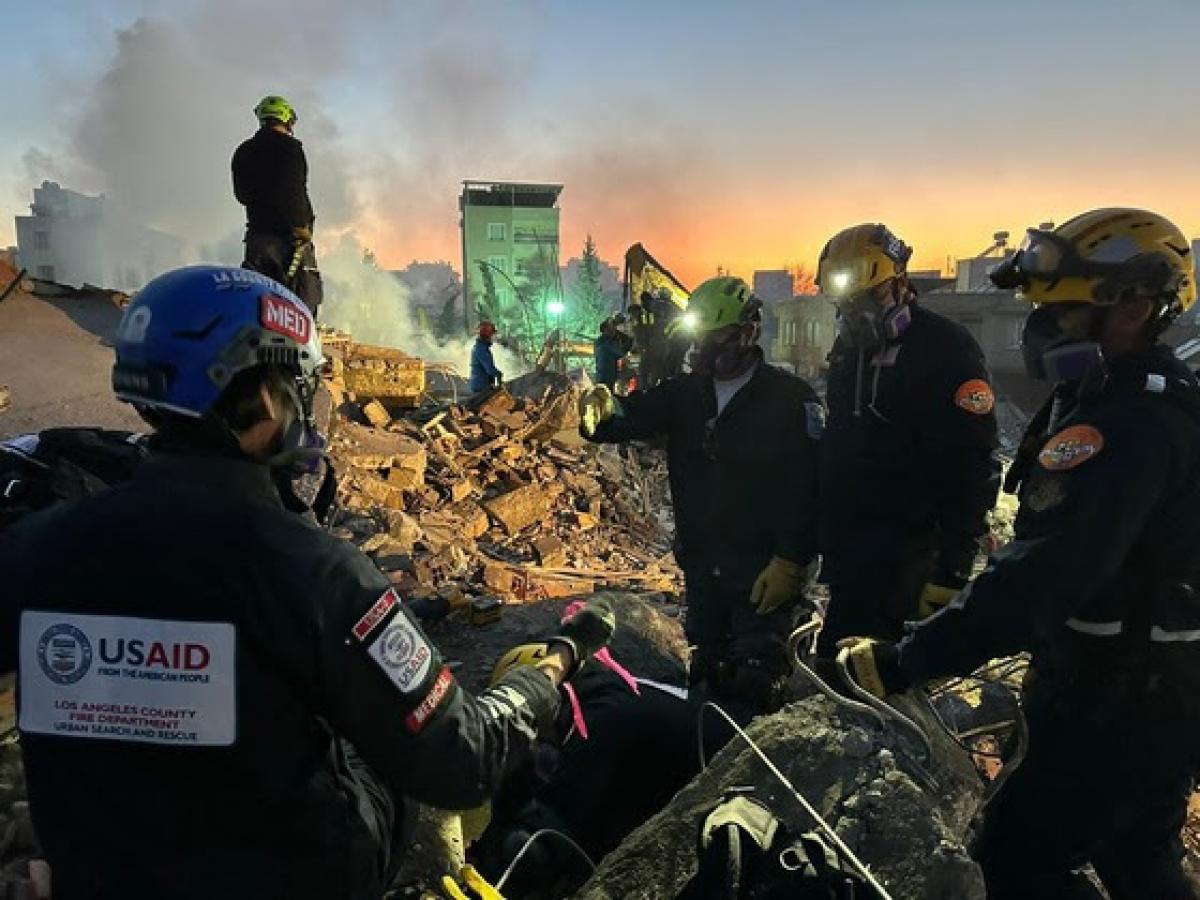
“When disasters strike, NASA is here to help – at home and around the world,” said NASA Administrator Bill Nelson. “As challenges from extreme weather grow, so too does the value of NASA’s efforts to provide critical Earth observing data to disaster-response teams on the frontlines. We’ve done so for years. Now, through this system, we expand our capability to help power our U.S. government partners, international partners, and relief organizations across the globe as they take on disasters – and save lives.”
The team behind NASA’s Disaster Response Coordination System gathers science, technology, data, and expertise from across the agency and provides it to emergency managers. The new system will be able to provide up-to-date information on fires, earthquakes, landslides, floods, tornadoes, hurricanes, and other extreme events.
“The risk from climate-related hazards is increasing, making more people vulnerable to extreme events,” said Karen St. Germain, director of NASA’s Earth Science Division. “This is particularly true for the 10% of the global population living in low-lying coastal regions who are vulnerable to storm surges, waves and tsunamis, and rapid erosion. NASA’s disaster system is designed to deliver trusted, actionable Earth science in ways and means that can be used immediately, to enable effective response to disasters and ultimately help save lives.”
Agencies working with NASA include the Federal Emergency Management Agency, the National Oceanic and Atmospheric Administration (NOAA), the U.S. Geological Survey, and the U.S. Agency for International Development – as well as international organizations such as World Central Kitchen.
“With this deliberate and structured approach, we can be even more effective in putting Earth science into action,” said Josh Barnes, at NASA’s Langley Research Center. Barnes manages the Disaster Response Coordination System.
NASA Disasters Team Aiding Brazil
When the floods and landslides ravaged parts of Brazil in May, officials from the U.S. Southern Command – working with the U.S. Space Force and Air Force, and regional partners – reached out to NASA for Earth-observing data.
NASA’s response included maps of potential power outages from the Black Marble project at NASA’s Goddard Space Flight Center. Disaster response coordinators at NASA Goddard also reviewed high-resolution optical data – from the Commercial Smallsat Data Acquisition Program – to map more than 4,000 landslides.
Response coordinators from NASA’s Jet Propulsion Laboratory and the California Institute of Technology produced flood extent maps using data from the NASA and U.S. Geological Survey Landsat mission and from ESA’s (the European Space Agency) Copernicus Sentinel-2 satellite. Response coordinators at NASA’s Johnson Space Center also provided photographs of the flooding taken by astronauts aboard the International Space Station.
Building on Previous Work
The Brazil event is just one of hundreds of responses NASA has supported over the past decade. The team aids decision-making for a wide range of natural hazards and disasters, from hurricanes and earthquakes to tsunamis and oil spills.
“NASA’s Disasters Program advances science for disaster resilience and develops accessible resources to help communities around the world make informed decisions for disaster planning,” said Shanna McClain, manager of NASA’s Disasters Program. “The new Disaster Response Coordination System significantly expands our efforts to bring the power of Earth science when responding to disasters.”
What's Your Reaction?






























